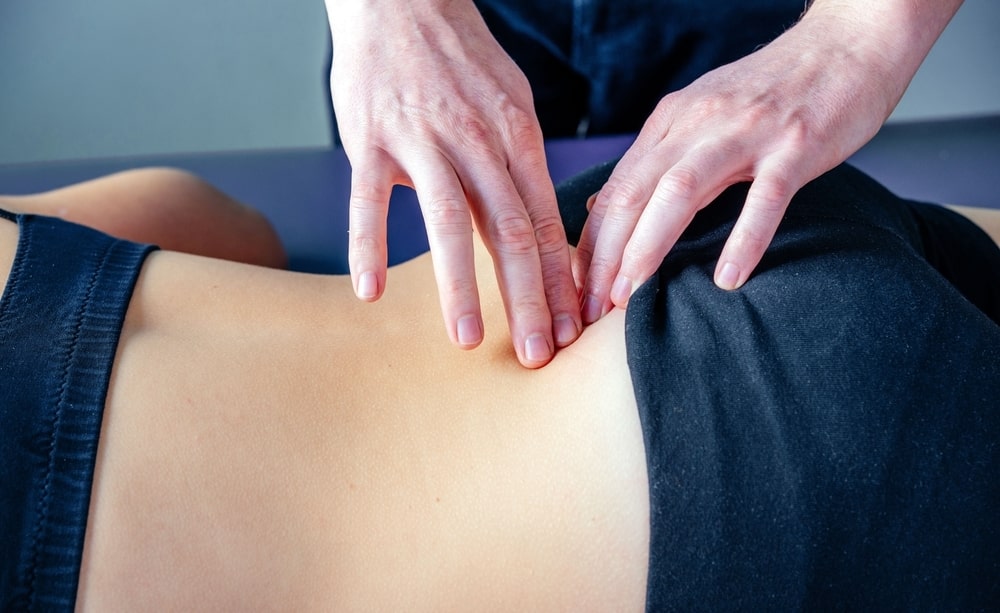
What is SIJ strain?
The sacroiliac joints (SIJ) are the joints that connect your lower spine to your pelvis. The sacrum (tail bone) connects to the ilia (pelvic bones).
In most people, the SIJ is a stiff joint that provides a stable link between the lumbar spine and pelvis, allowing only a few degrees of movement.
Causes:
In some people, due to either trauma, generalised joint hypermobility or pregnancy the SIJ has excess mobility, resulting in sheering forces through the joint that may cause pain and dysfunction. Pain in the SIJ due to hypomobility (too little movement) or hypermobility (too much movement) is referred to collectively as sacroiliac joint dysfunction.
SIJ hypomobility may be the result of conditions such as ankolyising spondylitis and is relatively uncommon, whereas joint hypermobility is far more common and will be discussed further.
The sacroiliac joint relies on both force closure and form closure to provide joint stability.
Form closure comes from the anatomical shape of the sacrum and iliac bones, as well as ligamentous support whilst force closure comes from the muscles that attach, and act around the SIJ to provide stability during movement.
Research shows that the most important muscles for SIJ stability are the deep gluteal muscles and the deep “core” muscles, specifically transverse abdominus.
When these muscles become weak, due to trauma or disuse the sacroiliac joints a vulnerable to excessive movement which may result in inflammation and irritation of the joint and surrounding tissues.
The sacroiliac joint may also be susceptible to excessive movement due to joint hypermobility, as a result of either generalised joint hypermobility or pregnancy.
During pregnancy hormones, a released that increase ligamentous laxity. This is to allow the pelvis to move during labour to allow the baby passage through the birth canal.
Unfortunately, this increase in ligamentous laxity, whilst essential for natural delivery of a baby can result in excessive movement of the sacroiliac joint and subsequently, pregnancy related pelvic girdle pain.
Symptoms:
SIJ pain may, at times, be difficult to distinguish from other back and hip injuries as it can behave in a similar way and cause radiation into the lower back, groin, buttock and even down the leg.
Common symptoms of SIJ dysfunction include:
- Pain in the lower back that may radiate into the hip/groin/gluteal region
- Pain that is worse with standing, walking.
- Pain may be aggravated by activities that cause shearing stresses through the pelvis such as rolling over in bed and getting in and out of the car
- Pain when lying on your side at night
- Pain with sitting cross legged
- Pain may be associate with hormonal changes in women, or during sexual intercourse.
Diagnosis:
Accurate diagnosis of SIJ dysfunction may be difficult as SIJ pain can often mimic mechanic low back pain or hip pain.
Clinical diagnosis by your physiotherapist is recommended as your physiotherapist will conduct various tests to deduce the primary cause of your pain. In many cases, there may be multiple contributing factors to low back and SIJ pain and the may exist concurrently. Your physiotherapist will conduct a thorough patient interview and physical examination to determine the cause of your pain.
Diagnostic imaging is not indicated in most instances as it has a poor correlation with symptoms. However, your physiotherapist may recommend imaging to screen for other conditions if necessary or if you are not improving with treatment.
Treatment:
Your physiotherapist will work with you to develop a treatment plan that is specific to you, and your goals. Physiotherapy management of SIJ dysfunction will typically involve several stages including:
- Decrease pain and inflammation
- Restore strength and neuromuscular control
- Return to daily activities/sport
- Maintenance to prevent reoccurrence of injury
My Physio My Health
Trust our team of physiotherapists to help you recover faster and improve your quality of life.

 WISHING EVERYONE A HAPPY NEW YEAR! WE'VE RETURNED TO OUR REGULAR OPENING HOURS
WISHING EVERYONE A HAPPY NEW YEAR! WE'VE RETURNED TO OUR REGULAR OPENING HOURS



